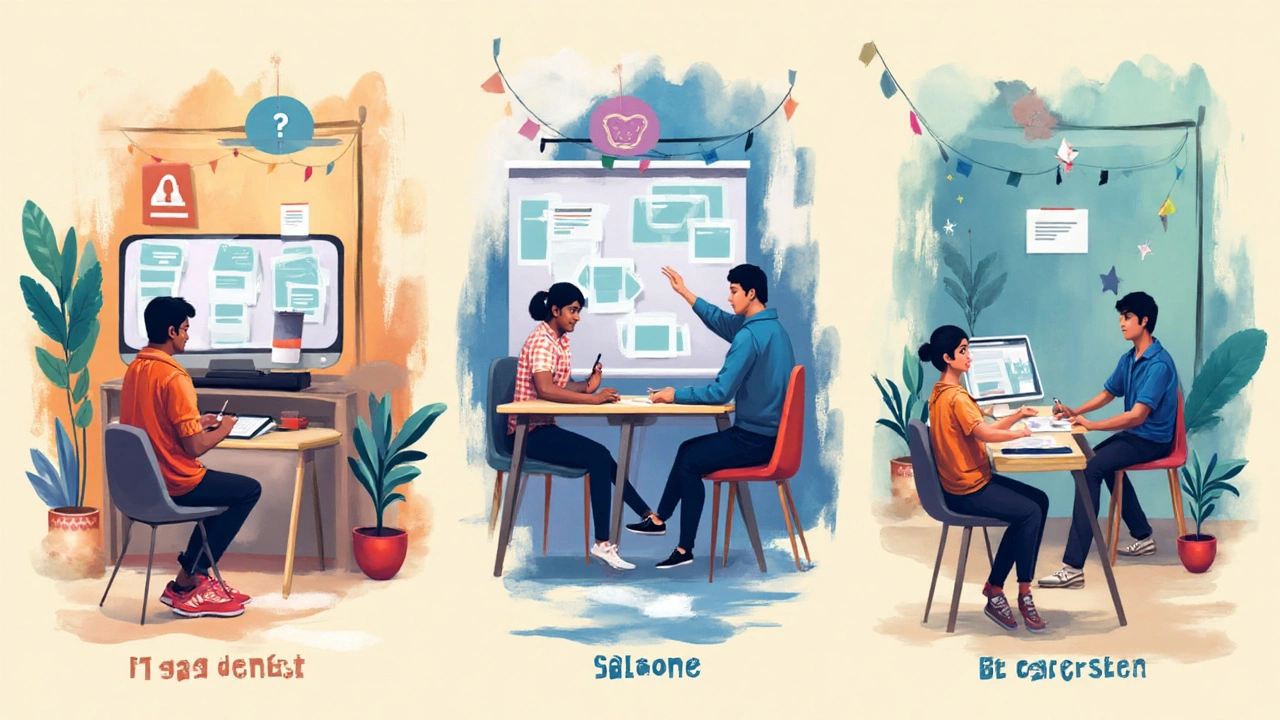Three months may sound short, but it’s enough to flip your career story. Ever heard of someone landing a job after a weekend workshop and wondered—what could I do with a little more time? Riya, my daughter, finished an online certificate in just 12 weeks and shocked us with a paid internship right after. Companies these days care more about what you can actually do than just how many degrees hang on your wall. In a world obsessed with speed, employers want skills they can use now—not vague promises for later. If you’re tired of waiting for the ‘perfect moment’ or think all training takes years, you’re in for a surprise. Let’s get right to it—what skills can you pick up in three months that’ll open doors to a solid job?
Fastest-Growing Skills That Get You Hired in 3 Months
Forget memorizing old textbooks. The job market lives and breathes on practical skills. In the post-pandemic hiring wave, companies shifted to shortlisting people who could prove their abilities—either through portfolios, certifications, or actual projects. Data from Naukri.com’s 2025 report shows that over 40% of new hires in fields like digital marketing, customer support, and coding had taken a short-term skills course. Recruiters often say, ‘Show us what you can do,’ not ‘Tell us what you know.’ This flips the game for anyone looking to break in fast.
The top short-term skills right now aren’t secret. If you can prove you can do them, you can get work, even remotely. Let’s talk specifics:
- Digital Marketing: Almost every business, from your local chai shop to online giants like Amazon India, needs help with social media, ads, and content. Short digital marketing courses (think SEO, Facebook and Insta ads, Google Analytics) have exploded on Udemy, Coursera, and Indian platforms. If you can run a Facebook campaign—even for a couple of thousand rupees—you already beat 70% of the job market. Practical tasks, like setting up an ad or writing a blog post, can be learned in a month. Give it three months, and you’ll have a decent portfolio.
- Coding (Frontend Development): JavaScript and HTML/CSS are the backbone of many entry-level tech jobs. Bootcamps like Masai School and freeCodeCamp turn complete beginners into junior developers within three months. The catch? You have to actually build things. Employers love small sample websites more than any certificate. Even basic Python or data analysis can set you apart—and YouTube has countless step-by-step guides.
- Graphic Design: Canva and Adobe Spark have made design accessible. Plenty of startups want people who can make websites, social posts, or logos pop. Free templates plus a tiny sense of color can open freelance or remote work opportunities. Do a three-month course, build a simple Instagram portfolio, and share your designs. If you enjoy visual work, this path is gold.
- Customer Service (Voice or Chat): English doesn’t have to be perfect—confidence and politeness matter more. Many companies, especially in e-commerce, hire for support roles based on your ability to communicate, solve small problems, and type quickly. A three-month stint learning customer handling tools and etiquette (try YouTube or LinkedIn Learning) can open doors even if you were in a very different field before.
- Basic Accounting and Tally: MSMEs and even big businesses need people who can do bookkeeping, especially with GST compliance everywhere. Tally—even on a basic level—makes you very employable in local offices, small businesses, or as a virtual assistant. Institutes like NIIT and IIM SKILLS offer crash courses with hands-on practice. In three months, you can go from knowing nothing to making entries, preparing invoices, and basic payroll.
Here’s a smart tip: Instead of trying to ‘master’ everything, focus on one stream and build a mini-project or online portfolio in that area. That toolkit is your golden ticket. Employers skim resumes; they dive deep into portfolios. A project you create in 90 days is often more impressive than an entire degree on paper.

How to Structure Your Learning for Maximum Impact
Three months go fast—but they’re enough if you stick to a plan. Here’s how you make it count. Start by picking that one skill you’re both interested in and that’s in demand. Searching ‘short-term job-oriented courses’ on YouTube gives you thousands of ideas, but don’t get lost scrolling. Check sites like Coursera, Udemy, and platforms run by Indian government and private institutes. Many offer scholarships, flexible timings, and even placement help.
Break the three months like this:
- First Month: Foundation—Focus on the basics, learn the vocabulary, and watch intro tutorials. If you’re into coding, start building tiny websites. Digital marketing? Start your own blog or run a tiny ad for practice.
- Second Month: Real Projects—Start applying what you’ve learned. Pick simple projects, freelance gigs, or help a friend’s business for free. Document every step: screenshots, results, and what you tried (even what failed—employers like honest tries).
- Third Month: Portfolio and Job Hunt—Put it together. Make a simple online portfolio, upload screen recordings, and create a PDF that shows your journey. Whip up a short video introduction. Then—get visible. Post your portfolio on LinkedIn, apply to 10 jobs a day, reach out to people in the industry on social media, or even knock on company doors (old school, but works!).
Two things I learned from friends who’ve jumped into jobs fast: consistency is everything, and feedback is gold. Don’t be scared of small mistakes. Most hirers expect beginners to stumble early. What matters is fixing and improving, not hiding or making excuses. Documenting your progress—literally, keeping a diary or weekly checklist—keeps you motivated and shows practical growth. If you’re stuck anywhere, join a Facebook or WhatsApp group for the skill you’re learning. Sharing struggles and small wins speeds up learning ten times over.
An underrated trick: set up a ‘mock project’ that solves a real problem around you. Designed a flyer for your local tiffin center? Made a website for a friend’s tuition class? Those go straight into your job portfolio. Employers want proof that you can solve practical problems—so make that the centerpiece of your learning journey.

Hidden Advantages and Surprises When You Learn Job Skills Quick
People often underestimate tiny bursts of learning. Three months doesn’t just teach you a new skill—it changes how you see your own potential. Something magical happens when you finish a real project or get positive feedback on work you did with your own hands. You start asking, ‘What else can I do?’
Short-term training comes with some hidden benefits that surprise many first-timers:
- Confidence Boost: Breaking out of a rut is easiest when you have a tick-the-box win. A beginner-friendly certificate or a real project you completed gives instant proof of capability. That’s priceless, especially if you’re switching fields or bounced after layoffs.
- Immediate Networking: When you sign up for popular three-month courses, especially the kind with live sessions or mentor support, you meet future co-workers, friends, or even future employers. Many people have gotten job offers right in WhatsApp study groups because someone noticed their effort or project.
- Better Earning Options: Even if you don’t land a full-time job right away, these new skills open up side gigs and freelance work. Sites like Fiverr, Upwork, and even Indian apps like Internshala have mini-tasks you can do from home—especially with digital marketing, graphic design, and coding basics. People have paid for simple logo designs, translated quick documents, or run small ad campaigns. It may start small, but it snowballs very quickly.
- Discovering New Interests: Sometimes, you take up digital marketing but end up realizing you love the creative part (like video editing) more than running ads. Three months is enough time to pivot—try a related micro-skill, add a project or two, and now you’re flexible for multiple job profiles. People who stick with the ‘T-shaped’ approach—deep in one area, but sampling others—stay more employable long term.
Another big surprise: employers value your ability to learn fast—almost as much as the actual skill. Companies know that industries shift every year. If you show that you mastered a job-relevant skill in under 100 days and can prove it with real work, you become way more attractive than someone with only outdated certificates. That story of ‘I did this in three months’ is a talking point in interviews and gets noticed.
Let’s not sugarcoat it—it takes actual sweat. Short courses pack a punch, but you need to clock in the hours. Most successful learners spend at least an hour a day, every day, focused on results. If you can commit that much, you’ll beat 90% who quit or get distracted. Set a timer, pick micro-goals (like one project a week), and get comfortable making, testing, and fixing things. Speed trumps perfection in today’s job hunt.
The job world in 2025 is wild: new opportunities keep popping up in places you wouldn’t expect. Remote work, freelance gigs, and micro-jobs aren’t just buzzwords—they’re paychecks. Short courses, bite-size projects, and smart portfolios are actual, proven paths to steady work. So, if you’re asking, ‘What can I learn in 3 months to get a job?’—believe me, with purpose, energy, and a handful of the right online resources, you can learn just about anything that gets you hired.
